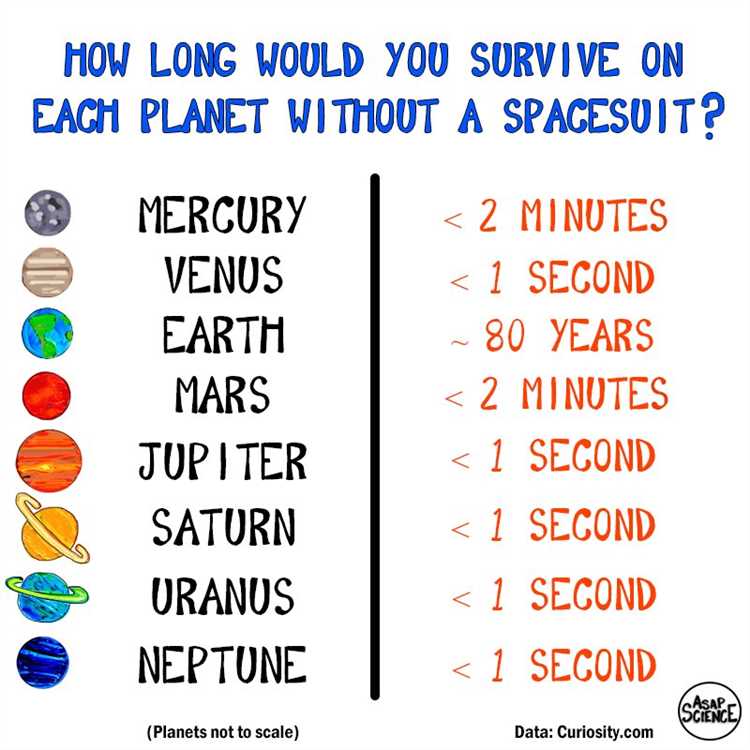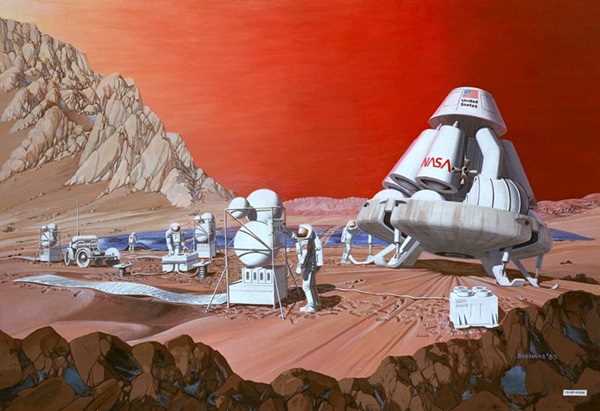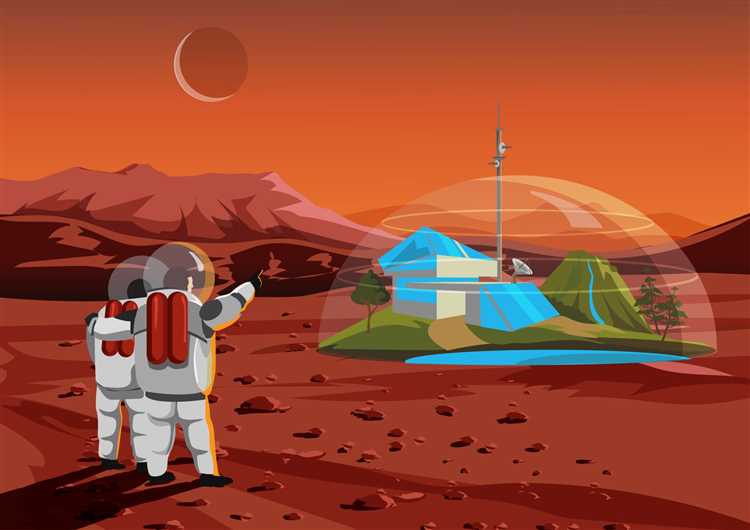
Mars, the fourth planet from the Sun and our nearest celestial neighbor, has long captured the imagination of scientists and space enthusiasts alike. With its dusty surface and harsh climate, Mars presents numerous challenges for human exploration and habitation. As space agencies around the world work towards manned missions to the Red Planet, one crucial question remains: how long can humans survive on Mars?
Surviving on Mars is no easy feat. The planet’s thin atmosphere offers little protection from cosmic radiation and solar flares, while dust storms and extreme temperatures pose additional risks. Furthermore, Mars lacks a magnetic field, which on Earth helps shield us from harmful radiation.
Studies and simulations have shown that prolonged exposure to Mars’ conditions can have detrimental effects on the human body. The lack of gravity and the lower atmospheric pressure can lead to muscle and bone loss, as well as cardiovascular and immune system issues. Furthermore, the limited resources and isolation on Mars would pose mental and psychological challenges for astronauts.
Despite these formidable obstacles, scientists are working tirelessly to develop technologies and strategies to ensure the long-term survival of humans on Mars. From investigating potential underground habitats to developing advanced life support systems, these initiatives aim to mitigate the risks and provide a sustainable environment for future settlers. The success of these endeavors will determine the feasibility and duration of human presence on the Red Planet.
- The Challenge of Mars Colonization
- Atmospheric Conditions on Mars
- Impact of Radiation on Human Health
- Food and Water Resources on Mars
- Food
- Water
- Mental Health and Isolation
- Effects of isolation on mental health
- Addressing mental health challenges
- Technological Advancements and Future Prospects
- Q&A:
- How long can humans survive on Mars?
- What are the main challenges humans would face while trying to survive on Mars?
- Is it possible to create a self-sustaining colony on Mars?
- What are the prospects for long-term survival on Mars?
The Challenge of Mars Colonization
Colonizing Mars is an ambitious and complex undertaking that presents numerous challenges for human survival. The Red Planet’s harsh environment, long distances from Earth, and limited resources make it one of the most difficult places in the solar system for long-term habitation.
One of the major challenges of Mars colonization is the extreme cold and low atmospheric pressure. The average temperature on Mars is around -80 degrees Fahrenheit, making it impossible for humans to survive without adequate protection and insulation. The thin atmosphere also provides little protection from harmful radiation, posing a significant health risk to astronauts.
Another challenge is the lack of readily available resources on Mars. The planet has a limited supply of water, which is essential for sustaining life. Establishing sustainable sources of water and creating efficient methods of extracting and utilizing it will be crucial for any long-term colonization efforts.
Transportation and communication present additional hurdles for Mars colonization. The distance between Mars and Earth can vary greatly depending on their respective positions in their orbits, which can result in communication delays of up to several minutes. This poses challenges for real-time decision-making and emergency situations.
Furthermore, the long duration of space travel to Mars raises concerns about the astronauts’ physical and mental health. Extended periods of weightlessness can lead to bone and muscle loss, cardiovascular problems, and decreased immune function. Finding ways to mitigate these effects and maintain astronauts’ well-being during the journey and on Mars will be crucial.
Overall, the challenges of Mars colonization require innovative solutions and a multidisciplinary approach. International collaboration, advanced technology, and rigorous planning will be key in ensuring the survival and success of future human missions to the Red Planet.
Atmospheric Conditions on Mars

The atmosphere on Mars is vastly different from that on Earth. It is thinner and contains less oxygen, making it impossible for humans to breathe without assistance. The average atmospheric pressure on Mars is only about 0.6% of Earth’s sea level pressure.
Mars’ atmosphere is primarily composed of carbon dioxide (CO2) with trace amounts of nitrogen and argon. This makes the Martian atmosphere very different from Earth’s, which is predominantly nitrogen and oxygen.
One of the challenges of living on Mars is the extreme temperatures. The average surface temperature on Mars is about -80 degrees Fahrenheit (-62 degrees Celsius), with temperatures dropping even lower at night. The thin atmosphere does not provide much insulation, causing the temperature to fluctuate greatly throughout the day.
The atmospheric conditions on Mars also pose a threat in terms of radiation. Due to the lack of a protective magnetic field like Earth’s, Mars is exposed to higher levels of solar and cosmic radiation. This presents a significant risk to human astronauts, as prolonged exposure to this radiation can lead to various health issues.
Despite the harsh atmospheric conditions, scientists continue to explore ways to make Mars habitable for humans. Future missions will focus on developing technologies to create artificial environments or to use the planet’s resources to sustain human life.
Impact of Radiation on Human Health
Radiation is one of the most significant challenges that humans would face in a long-term mission on Mars. The Red Planet has a much thinner atmosphere compared to Earth, resulting in reduced protection from solar radiation and cosmic rays. The absence of a strong magnetic field on Mars further exacerbates the radiation problem.
Exposure to high levels of radiation can have severe consequences on human health. It can damage human DNA, increase the risk of cancer, and lead to long-term health problems. In the short term, radiation sickness can occur, causing symptoms such as nausea, vomiting, fatigue, and even death in extreme cases.
To mitigate the impact of radiation on human health during a Mars mission, several measures can be taken. The design of the spacecraft should include shielding materials to reduce radiation exposure. Living spaces on Mars should be built underground, as the Martian soil can provide some natural shielding against radiation.
Additionally, astronauts should follow strict protocols for radiation monitoring and protection. This includes using personal dosimeters to measure radiation levels, minimizing exposure time outside shielded areas, and wearing protective clothing such as lead vests.
Research is also ongoing to develop advanced radiation mitigation techniques. These include the use of artificial magnetic fields or radiation shielding materials specifically designed for Mars environments. The understanding of the health risks associated with radiation exposure and the development of countermeasures will be crucial for ensuring the long-term survival of humans on Mars.
- Damage to human DNA
- Increased risk of cancer
- Long-term health problems
- Radiation sickness (nausea, vomiting, fatigue, and death)
Measures to mitigate radiation impact:
- Design spacecraft with shielding materials
- Build living spaces underground for natural shielding
- Strict protocols for radiation monitoring and protection
- Research on advanced radiation mitigation techniques
In conclusion, radiation poses a significant threat to human health on Mars due to the planet’s thin atmosphere and lack of a strong magnetic field. However, with the implementation of proper shielding, protocols, and ongoing research, the impact of radiation can be mitigated, ensuring the overall well-being and long-term survival of humans on the Red Planet.
Food and Water Resources on Mars
Mars is a harsh and inhospitable environment for human life. One of the biggest challenges for future Martian settlers will be ensuring a sustainable and reliable source of food and water. Without these vital resources, survival on Mars would be impossible.
Food
Producing food on Mars will require innovative solutions and technologies. Traditional farming methods may not be feasible due to the lack of soil, limited sunlight, and extreme temperatures. However, there are alternative methods that could be employed, such as hydroponics or aeroponics. These methods involve growing plants without soil, instead using nutrient-rich water or mist. Research is currently underway to develop and test these systems for Mars mission simulations.
Another potential source of food on Mars is synthetic biology. Scientists are exploring the possibility of genetically engineering organisms that could produce food using the available resources on Mars. These organisms could be designed to convert Martian soil or atmospheric gases into nutritional substances.
Water
Water is crucial for sustaining life, and finding sources of water on Mars will be a top priority for future missions. Scientists believe that water exists in the form of ice in the Martian polar caps and underground. Extracting and purifying this water will be a challenging task, but it is essential for long-term survival on the planet.
In addition to harvesting Martian water, it may also be possible to generate water on Mars through the process of electrolysis. This involves breaking down water molecules into hydrogen and oxygen through the application of electric currents. The hydrogen could be used as fuel, while the oxygen could be used for breathing and as an oxidizer for rocket propellant.
Another option is to bring water from Earth to Mars. However, transporting large amounts of water would be costly and impractical. Therefore, it would be more efficient to rely on local resources as much as possible.
Overall, ensuring a sustainable food and water supply on Mars will be a complex and challenging task. It will require a combination of advanced technologies, scientific research, and careful planning. However, with continued advancements in space exploration, it is not impossible to imagine a future where humans can thrive on the Red Planet.
Mental Health and Isolation
Mars is an inhospitable environment for human life, and one of the biggest challenges that astronauts will face is the mental toll of living in isolation. The journey to Mars can take anywhere from six to nine months, during which time astronauts will be confined to a small spacecraft with limited human interaction. Once on the Red Planet, there will be no possibility for immediate return, and astronauts will have to live and work in close quarters with their fellow crew members for months, or even years, at a time.
Isolation can have a significant impact on mental health. Humans are social beings, and being cut off from society and familiar surroundings can lead to feelings of loneliness, anxiety, and depression. The lack of sensory stimulation and the monotonous routine of life on Mars can further exacerbate these feelings.
Effects of isolation on mental health

Research conducted on astronauts in space and individuals living in extreme environments on Earth has shown that isolation can result in a range of psychological and emotional issues. Some common effects include:
- Depression: The long duration of the mission and the absence of familiar experiences and interactions can lead to feelings of sadness, hopelessness, and a loss of interest in activities.
- Anxiety: The uncertainty of living in an isolated and unfamiliar environment can cause heightened levels of anxiety and stress.
- Loneliness: The absence of close relationships and the inability to communicate with loved ones back on Earth can create feelings of loneliness and isolation.
- Cognitive Decline: The lack of mental stimulation and the monotony of life on Mars can lead to decreased cognitive function and difficulty concentrating.
Addressing mental health challenges
Astronauts going to Mars will need to be resilient and mentally prepared for the challenges they will face. Prior to the mission, extensive psychological evaluations will be conducted to identify individuals who are psychologically fit for the rigors of long-duration space travel. Additionally, astronauts will undergo rigorous training that includes psychological support and coping strategies to help them maintain their mental well-being.
Once on Mars, it will be crucial to establish regular communication with mission control and provide astronauts with opportunities for recreational activities and personal time to help combat feelings of isolation and monotony. Virtual reality technologies, such as simulated Earth environments and the ability to communicate with loved ones through virtual means, may also help astronauts maintain a sense of connection and familiarity.
Overall, while the physical challenges of survival on Mars are significant, the mental health and well-being of astronauts will also require careful attention and support in order to ensure their long-term success and adaptability in the harsh Martian environment.
Technological Advancements and Future Prospects
As the exploration and colonization of Mars become a real possibility, technological advancements are crucial in ensuring the survival and longevity of humans on the Red Planet. Scientists and engineers continue to develop innovative solutions to overcome the challenges posed by the harsh Mars environment.
One of the key areas of focus is the development of sustainable food production systems. Mars has a limited availability of natural resources, making it necessary to find alternative methods to grow food. Researchers are exploring the potential of hydroponics and aeroponics, which involve growing plants without soil, as well as using genetically modified crops that are resistant to the harsh conditions on Mars. These advancements in agriculture will be essential in providing a sustainable food source for future Martian settlers.
To address the issue of limited water resources on Mars, scientists are also working on technologies to extract water from the planet’s subsurface ice. This water can then be purified and used for various purposes, including drinking, irrigation, and fuel production. The development of efficient and lightweight water extraction and purification systems will be critical in establishing a self-sustaining colony on Mars.
Another major technological advancement is the development of advanced life support systems. These systems will be responsible for providing astronauts and future settlers with a breathable atmosphere, regulating temperature and humidity, removing toxins, and recycling waste. It will be necessary to create closed-loop systems that can efficiently recycle air, water, and waste products, reducing the reliance on Earth for resupply missions.
Furthermore, advancements in 3D printing technology offer promising prospects for Mars missions. 3D printers can be used to manufacture spare parts and tools on-demand, eliminating the need for extensive pre-mission planning and reducing the weight and volume of supplies required for Martian missions. This technology has the potential to revolutionize space exploration and significantly extend the duration of human missions on Mars.
In conclusion, numerous technological advancements are being made to enable long-term human survival on Mars. From sustainable food production to water extraction and purification, advanced life support systems, and 3D printing technology, these innovations hold great promise for the future of Martian colonization. With continued research and development, humans may one day thrive on the Red Planet.
Q&A:
How long can humans survive on Mars?
Survival time on Mars for humans would depend on a variety of factors, including access to resources, technological advancements, and the ability to adapt to the harsh conditions. Currently, it is estimated that with the right equipment and support, humans could survive on Mars for a few months to a year.
What are the main challenges humans would face while trying to survive on Mars?
Humans would face numerous challenges on Mars, including the lack of breathable air, extreme temperatures, low gravity, radiation exposure, and limited resources such as food, water, and energy. These challenges would require careful planning and advanced technologies to overcome.
Is it possible to create a self-sustaining colony on Mars?
Creating a self-sustaining colony on Mars is a complex task, but it is theoretically possible. It would require establishing systems for producing food, generating energy, recycling water, and managing waste. Additionally, the colony would need to be able to protect itself from the harsh Martian environment and provide suitable living conditions for humans.
What are the prospects for long-term survival on Mars?
The prospects for long-term survival on Mars are still uncertain and would depend on advances in technology and our ability to overcome the challenges of living on the planet. With ongoing research and exploration, it is possible that humans could eventually develop the necessary infrastructure and systems to sustain a long-term presence on Mars.